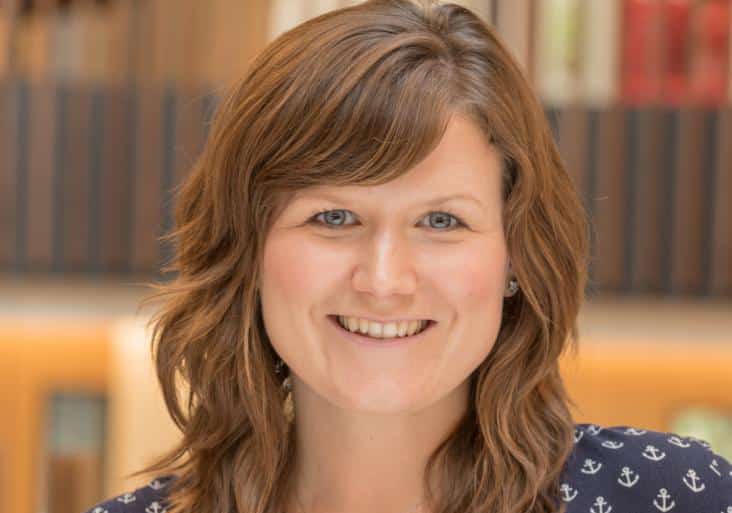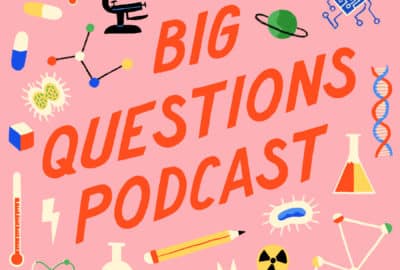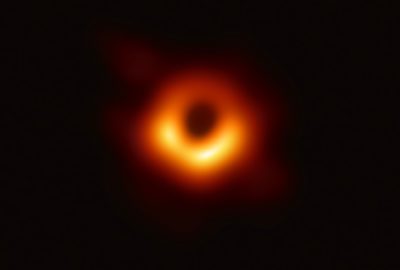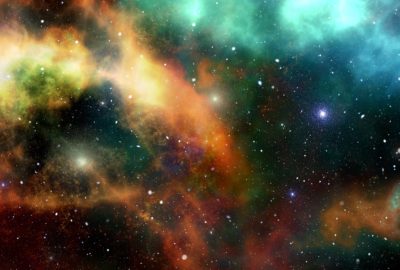What’s the cool stuff that we’ve learnt from the James Webb Space Telescope?
Wednesday 5th Jul 2023, 12.30pm
About a year ago, we asked astrophysicist Dr Becky Smethurst why the James Webb Space Telescope is such a big deal. Her answers were pretty exciting, to say the least. So, in the months that have passed since then, what has it found out? What mysteries of the Universe has it begun to unravel, and has it lived up to expectations? We got back in touch with Becky for an update.
This is the last episode in this series of the Big Questions Podcast! We hope you’ve enjoyed learning about everything from Martian craters to the human microbiome. Be sure to look out for our next series, beginning in October 2023, and until then, you can find a catalogue of our episodes right here on the Oxford Sparks website. Have a big question that you’d like answered next series? Let us know on social media!
Emily Elias: About a year ago we were all jazzed about the launch of the James Webb Space Telescope, or JWST for the cool kids. It promises the chance to look at some of the biggest mysteries of the universe. So, one year on, the JWST has been floating around up there, what the heck has happened?
On this episode of The Oxford Sparks Big Questions Podcast, we’re asking what’s the coolest tip that we’ve learned from the James Webb Space Telescope.
Hello, I’m Emily Elias, and this is the show where we seek out the brightest minds at the University of Oxford, and we ask them the big questions.
And for this one, we’re turning to our friend of the podcast and all around amazing researcher who loves gazing at the galaxies.
Becky Smethurst: My name’s Dr Becky Smethurst, I am an astrophysicist here at the University of Oxford, and I am studying how super massive black holes grow and evolve with their galaxies.
But you might also know me as Dr Becky from YouTube, where I chat about space to anyone who will listen. (Laughter)
Emily: It’s a very excellent YouTube channel, we should get that plug in right away at the top.
Becky: (Laughter)
Emily: Okay, we talked to you last year, and it was like, there’s this amazing space, a telescope going up into the skies, we’re going to learn so much. What the heck has happened in the past 12 months since that last podcast came out?
Becky: Basically, every astronomers’ dream has happened in the past 12 months.
First of all, the launch of that telescope went so well that we now know we’re going to have it for, like, 20 years, rather than maybe five if we’re lucky that we were all sort of working towards. So, it’s going to give us so much more science.
In the past year it’s proved itself beyond whatever we could’ve imagined. So, it’s outperforming our sort of best case scenario that we all had in mind as well.
It’s giving us clearer images, it’s detecting fainter things, and every proof of concept that’s been tested, like, “Oh, we would love to do this with it but we’re not sure if that’s going to work.”
They’ve tried it, clever minds have managed to analyse that data, bring it together how they need it, and it’s been shown that we can do a lot of the stuff that we hoped with JWST as well.
So, I don’t think there’s a single area of research in astronomy and astrophysics that hasn’t been affected by JWST in the past 12 months.
Emily: Because occasionally you see a picture pop up on your various news apps of, like, “Wow, this looks really spectacular.” But as a non-physicist, that information probably isn’t really hitting the right way. Like, it must hit so much deeper for you than, “Oh what a pretty picture.”
Becky: Yes, massively so. I think having that sort of understanding of, “Wow, that’s beautiful,” but, “Hey, that’s showing this,” and “Oh, that means this,” like, it’s that connection that gives you the goosebumps in a way.
And that’s what I try and get across a lot of the time on my YouTube channel and hopefully we’ll get to it in this podcast as well, where just getting that sense of, “This is what this means overall, this is the extra sort of meaning behind this image of why we’ve done this, and this is why we’re all so excited about it.”
And those images as well, they are fantastic, and I’m so glad they are as spectacular, and the public are finding them as spectacular as, like, the Hubble Space Telescope images.
Because I think that was what sort of people were concerned about, was that Hubble has been giving us such incredible images for, what, 30 years, that were all invisible wavelengths that we could see with our eyes to visible light. Whereas, JWST looks at infrared light, which we can’t see with our eyes.
So, everyone was a bit concerned about whether people would find the images as spectacular, but forgetting that one of the ways that we pass information is through colour.
So, what we do is even though we’re taking infrared images and we’re letting in light at shorter wavelengths, and then longer wavelengths, and getting these different images that we can compare.
And we know that in the shorter wavelengths that’s what the hotter things are giving off, and in the longer wavelengths, that’s what cooler things are giving off.
And if we still colour those red and blue and bring them together, you then get so much information out of the image, even if it’s not true colour, it’s like a false colour.
And so, they’re still spectacular to look at, but they’re also really informative in a science way as well. I guess just a really easy way to be like, “Oh, I can process that data that’s being shown to me in this way.”
Emily: Well, let’s dive into it, okay. So, like, there’s a laundry list of things that you wanted to learn, what is something that we’ve actually been able to tell from the JWST?
Becky: One thing that we didn’t expect is that JWST has been detecting galaxies at greater distances than we ever thought would be possible with it.
So, I mean the reason that we went for an infrared telescope was because the universe is expanding, so galaxies in the very early universe that give out visible wavelengths of light, that visible wavelength gets stretched out by the expansion of the universe until it becomes wavelengths that we can’t see with our eyes anymore. They’re not visible wavelengths, they’re into the infrared.
So, if we want to see things at greater, greater distances that have travelled longer though the expanding universe, then you need an infrared telescope to do it. And you also need a really big telescope as well, because that light is so faint by the time it reaches us.
So, that’s what JWST has been able to do, but the distances are, like, I’m hearing the numbers and I’m just like, “Wait, no, that’s not a thing.”
So, I mean, the way that we measure this, the sort of number we use is we put a number on the red shift, it’s like a factor of how much the light has been shifted by, and that correlates with the amount of time it’s been travelling through the universe, and therefore the distance away that that galaxy was when it emitted the light.
So, we can translate that into like, “Oh, these galaxies are 13.5bn light years away.” But the number we tend to use as astronomers is the red shift factor.
And to put it into context, with the Hubble Space Telescope, we were detecting the most distant galaxies at red shift of 9, and there’s now claims of galaxies at red shift of 20 with JWST.
Emily: That’s like an emoji of my brain exploding. So, like a double plus-
Becky: Hmmhmm.
Emily: … of what you thought was previously possible.
Becky: Yes. And if you had asked me, like, 12 months ago, I would’ve been like, “Oh you know, if we get stuff at, like, red shift 12 or 13 or maybe even 15, that would be the dream,” but there’s these claims of red shift 20 popping up all over the place.
And you know, okay, we’re going to take them with a grain of salt because they are sort of like best guesses at the minute, they’re not confirmed. But still, just even hearing that number, I would’ve thought you were mad 18 months ago if you had said that to me.
Emily: So, what are we able to then, like, tell? So, they’re brighter and further away?
Becky: Yes, so it’s detecting basically like the fainter and smaller things than we thought would be possible, which is the further away things as well. So, that’s what’s so exciting, is it’s showing that the telescope is performing better than we ever thought.
Then you’ve got the issue of once you’ve found them, you then look at their properties. And this is something else I wanted to talk about, was that when we’re looking at these galaxies that are at incredible distances, we’re seeing them as they were when the universe was very young.
So, the universe is about 13.8bn years old now, but when we look at these galaxies, we’re seeing them when the universe was 500,000,000m years old. So, that might sound quite old, but it’s a baby in terms of the universe’s lifetime.
So, we’re seeing it when the universe was completely different to what it is now, much denser and very different in terms of the conditions you have.
So that teaches a lot about how galaxies formed in the early universe. You know, we literally see them as they were then, so it’s like a little time machine. And then we can compare them to how galaxies are now.
And we obviously have our sort of best models of the universe and how everything formed. How did stars collapse and form in the first place, and how did these galaxies of stars all come together?
And we have our models of how that happened, and also what rate that happens at because for a star to form, people often think, oh, it has to be really hot for a star to form because you need stars to get hot to make hydrogen atoms come together and then fuse together to make helium.
But actually, it needs to be quite cold. Really counter intuitively. And that’s because if you have, like, you know, what stars are made of is hydrogen gas and you can imagine the molecules in that gas if they are very hot and they have lots of energy, the molecules will just ping around like crazy, and they’ll never actually clump together enough under gravity to get dense enough to then form like an actual clump of material where you can then have a star forming.
Emily: Like, if you’re really hot, you stretch out, and if you’re really cold, you curl up into a ball and you shiver.
Becky: Yes. (Laughter) I like that analogy. Yes, exactly. So, if we think about what the universe was like early on, it was obviously a lot denser because it had not expanded yet, so it was very, very dense, and everything close together. Stuff was a lot hotter. So, there was a certain rate at which stuff could cool at and then stars could form.
And so, there’s almost like a limit that as you look back further and further in time to greater and greater distances away from us, you’re like, “Okay, well there’s a limit to how big a galaxy can be at that time,” because there’s just not been enough time for stars to form, for the universe to cool enough.
But the ones that we’re seeing that we never thought we would be able to actually detect with JWST at these great distances, they’re brighter than we think they should be in terms of our models. They’re much brighter than we expected.
So, if they’re brighter, that means there’s more stars there, and so somehow they’ve been able to form more stars than we think should be possible, given our models right now.
Emily: Okay, so that’s stars, but what about little planets, the teeny, tiny exoplanets that I hear so much about?
Becky: So, planets are probably not actually that common in the early universe. At least not planets like Earth. Planets like Jupiter and Saturn maybe, because they’re made of gas, right. They’re made of hydrogen mostly, just like the sun. It’s just they’re kind of like a failed star in a way, right, they’ve just not kickstarted fusion, they’re just sort of inert gas balls.
That would be fine because there’s a lot of hydrogen in the early universe, but there’s not a lot of things like carbon and oxygen and things that make up us and earth and rocky planets. And that’s because those elements are formed in stars when they go supernova and then dispersed out into the universe.
And so, you need a high enough concentration of very heavy elements from enough generations of stars to start making rocky planets like Earth.
Emily: And so, are we seeing that with the JWST?
Becky: No. So, in terms of planets in the early universe, no, we can’t spot them, they’re too small. But in terms of planets in our own galaxy, the Milky Way – so very, very close by, I’m talking, like around stars less than a few thousand light years away that we’re sort of currently seeing what they’re like in our sort of back garden of the universe – we are seeing lots of those.
And this is another reason why JWST, as a very big telescope in the infrared, it was so useful to exoplanet studies because first of all, a big telescope means you can detect very faint things. What’s very faint? A tiny planet around a star. (Laughter) So that’s very useful.
But also, the infrared aspect of it is great because if you can take the light from a star that has passed through a planet’s atmosphere on its way to us…
So, imagine you’ve got a planet in orbit around a star, it passes in front of it’s star from our perspective, and a little bit of that starlight goes through the atmosphere of the planet, whatever molecules are present in that atmosphere will leave an imprint on that light.
Some of them steal away, like, specific colours or wavelengths of light, and so you can see them as like gaps if you take that light and then split it through a prism to get sort of the rainbow, and sort of like a trace of light of how much light at each wavelength you get, and you see these, like, dips in the light in planet atmospheres.
And what we’re essentially looking for is these fingerprints of molecules. And the molecule that is very active in the infrared that likes to steal lots of infrared wavelengths of light is water.
So, we can look for water in the exoplanet atmospheres, but also things like carbon dioxide and carbon monoxide, and ammonia and methane, and lots of other molecules as well that could point towards life existing on those planets.
Emily: Okay, so we’ve learned a lot of stuff so far, and we still have some questions that need to be explored. What is the conversations that are happening about the sort of stuff that we’re waiting to hear about? What are some of the debates and crises that are going on?
Becky: (Laughter) Crisis is a good word, actually, because there is one thing that I think is on the forefront of at least a lot of people’s minds in the field that I work in, and it’s called ‘The Crisis in Cosmology’.
And essentially we have two ways of – two main ways, anyway – of measuring the age of the universe and the expansion rate of the universe.
The first way is from what’s called the cosmic microwave background, which is essentially the first light that was ever released in the universe. And it basically contains this imprint of what the very early universe was like.
And essentially what we can do is compare that to what the universe looks like now and build a model to be like, “How do you turn that into this?”
And that model then gives us, “Okay, this is how long it would take, this is how much the universe would’ve expanded,” and we get a value from that.
The other way is to look at the distances to galaxies nearby-ish, and then measure how fast they’re moving away from us. So, you get how fast they’re moving away and at what distance, and with that you can work out the rate of expansion, and then the age of the universe.
And we get a value from that method that doesn’t agree with the other method. (Laughter) And they did agree, maybe 10 years ago, like, within error, but in the past 10 years, they’ve just slowly drifted apart, to the point where they don’t agree even within, like, the errors on our measurements anymore.
So, there’s a huge problem there. And one of the things that people think it could be, is that there is an issue with how we’re measuring the distances to the galaxies nearby.
And the way we do this is with supernova that always go off at the same brightness. And so, you spot a supernova and you’re like, “Okay, I know how bright it should be from how bright it appears, I can tell the distance of that galaxy.”
But to do that, you’ve got to measure how bright it appears, and with a supernova it can blend with a lot of other stars around it, especially at the distances that you’re looking at. So, you can’t resolve the individual stars, so you can’t know for sure which bits of the light that you’re looking at are actually from the supernova.
So, with JWST though, because it’s such a big telescope, you can resolve smaller things. And so, what people are hoping JWST will do is resolve these supernova and get a much more accurate measurement of their brightness, and then that will change how far away we think these galaxies are, and that will change our measurement of the rate.
And that should bring it back to in agreement with our measurement from the other way that we measure this from with the cosmic microwave background and our big models of the universe.
And again, we’ve been waiting and waiting and waiting for this data to come out because we know it’s been taken, and it’s just a matter of time before it gets released. And I think that’s going to have such a massive impact across the whole field of astronomy, because if it doesn’t find any difference, that’s where we know that stuff’s hit the fan (Laughter) if that’s the case.
Because that could be back to the drawing board on sort of our models of the entire universe. There could be something wrong in there. So, it’s really sort of exciting, but also, like I’m a little bit sort of nervous, almost, to see the results.
Emily: Yes, I can feel the anxiety.
Becky: Yes, it’s nervous, but it’s like exciting nervous, because if we do have to go back to the drawing board, that is kind of exciting though because it would mean brand new physics that we would learn at the same time. It’s just going to take a lot of effort (Laughter) and a lot of time.
Emily: Don’t worry, you don’t need to sleep anymore, it’s fine.
Becky: (Laughter)
Emily: This podcast was brought to you by Oxford Sparks from the University of Oxford. With music by John Lyons and a special thanks to Dr Becky Smethurst.
Tell us what you think about this podcast. You can find us on Twitter, on Facebook, on Instagram. We are @oxfordsparks. We have also got a website, oxfordsparks.ox.ac.uk.
This is our last episode for a while but get your big questions ready and we will try and answer them next season.
I’m Emily Elias. Bye for now.
Transcribed by UK Transcription.





